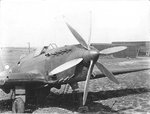wuzak
Captain
A specification for the Fairey P.24 "prince" engine gave power as:
For 87 octane fuel ("power curve 1393"):
1,500hp @ 12,000ft and 2,600rpm (normal)
1,600hp @ 15,000ft and 3,000rpm (maximum)
For 87/100 octane fuel ("power curve 2604"):
1,760hp @ 12,000ft and 2,600rpm (normal)
1,900hp @ 15,000ft and 3,000rpm (maximum)
Also, the intake arrangements were as discussed above - the supercharger discharges into a pipe which has 4 outlets that feed into galleries cast into the crankcase, then from there through galleries cast in the side of the engine blocks and into the head.
For 87 octane fuel ("power curve 1393"):
1,500hp @ 12,000ft and 2,600rpm (normal)
1,600hp @ 15,000ft and 3,000rpm (maximum)
For 87/100 octane fuel ("power curve 2604"):
1,760hp @ 12,000ft and 2,600rpm (normal)
1,900hp @ 15,000ft and 3,000rpm (maximum)
Also, the intake arrangements were as discussed above - the supercharger discharges into a pipe which has 4 outlets that feed into galleries cast into the crankcase, then from there through galleries cast in the side of the engine blocks and into the head.

